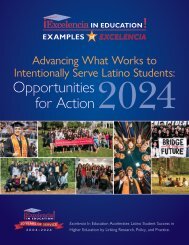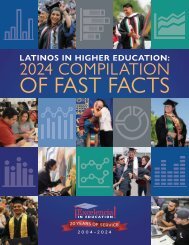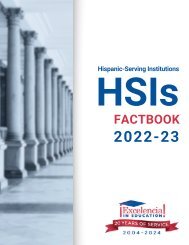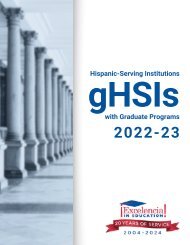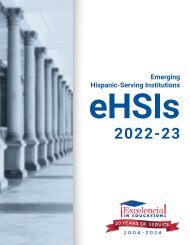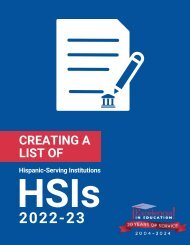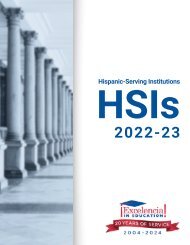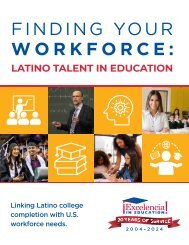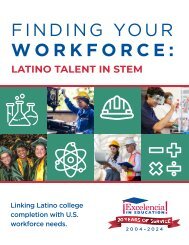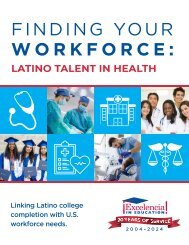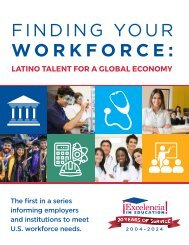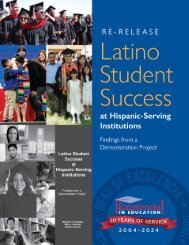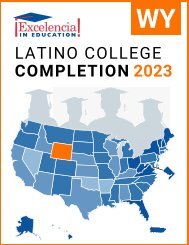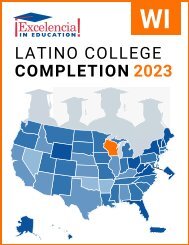Latino College Completion 2023: South Carolina
You also want an ePaper? Increase the reach of your titles
YUMPU automatically turns print PDFs into web optimized ePapers that Google loves.
SC
LATINO COLLEGE COMPLETION:<br />
SOUTH CAROLINA – <strong>2023</strong><br />
For the U.S. to regain the top ranking in the world for college degree<br />
attainment, <strong>Latino</strong>s will need to earn 6.2 million degrees by 2030. 1<br />
FAST FACTS<br />
STATE RANKING:<br />
<strong>South</strong> <strong>Carolina</strong> had the 29th largest<br />
<strong>Latino</strong> population in the U.S.<br />
K-12 POPULATION:<br />
In <strong>South</strong> <strong>Carolina</strong>, 10% of the K-12<br />
population was <strong>Latino</strong>. 2<br />
POPULATION:<br />
In <strong>South</strong> <strong>Carolina</strong>, 6% of the<br />
population was <strong>Latino</strong>. 2<br />
MEDIAN AGE:<br />
The median age<br />
of Hispanics<br />
in <strong>South</strong> <strong>Carolina</strong><br />
was 27, compared<br />
to 44 for White<br />
non-Hispanics. 2<br />
27<br />
Hispanics<br />
44<br />
White<br />
non-Hispanics<br />
ENROLLMENT:<br />
In <strong>South</strong> <strong>Carolina</strong>, 15% of<br />
Hispanics (ages 18 to 34) were<br />
enrolled in higher education, compared<br />
to 21% of White non-Hispanics. 2<br />
DEGREE ATTAINMENT:<br />
In <strong>South</strong> <strong>Carolina</strong>, 28% of Hispanic<br />
adults (25 and older) had earned an<br />
associate degree or higher, compared to<br />
46% of White non-Hispanic adults. 2<br />
Hispanic Adults = 2.8 of 10<br />
To reach the degree attainment goal by 2030, the U.S. can: close<br />
the degree completion gap by accelerating <strong>Latino</strong> completion while<br />
increasing for all students and scale up programs and initiatives that<br />
work for <strong>Latino</strong>, and all, students. The following demographics,<br />
institutional data, and practices inform <strong>Latino</strong> degree attainment.<br />
ENROLLING: Top 5 Institutions (Hispanic Undergraduates) in <strong>South</strong> <strong>Carolina</strong>, 2021-22<br />
Institution<br />
Sector<br />
Grand<br />
Total<br />
Hispanic<br />
Total<br />
5 University of <strong>South</strong> <strong>Carolina</strong>-Upstate Public, 4-year 1,135 67 6%<br />
NOTE: We use the terms <strong>Latino</strong> and Hispanic interchangeably in this factsheet.<br />
Source: Excelencia in Education analysis using U.S. Department of Education, National Center for<br />
Education Statistics (NCES), Integrated Postsecondary Education Data System (IPEDS), 2021 Fall<br />
Enrollment, Graduation Rates Survey and Institutional Characteristics Survey.<br />
%<br />
Hispanic<br />
1 Clemson University Public, 4-year 21,577 1,558 7%<br />
2 University of <strong>South</strong> <strong>Carolina</strong>-Columbia Public, 4-year 26,430 1,440 5%<br />
3 Greenville Technical <strong>College</strong> Public, 4-year 7,884 995 13%<br />
4 Trident Technical <strong>College</strong> Public, 2-year 8,755 754 9%<br />
5 <strong>College</strong> of Charleston Public, 4-year 9,770 692 7%<br />
ASSOCIATE DEGREES: Top 5 Institutions Awarding to Hispanics in <strong>South</strong> <strong>Carolina</strong>, 2020-21<br />
Institution<br />
Sector<br />
Grand<br />
Total<br />
Hispanic<br />
Total<br />
%<br />
Hispanic<br />
1 Greenville Technical <strong>College</strong> Public, 4-year 1,184 121 10%<br />
2 Horry-Georgetown Technical <strong>College</strong> Public, 2-year 995 64 6%<br />
3 Midlands Technical <strong>College</strong> Public, 2-year 993 58 6%<br />
4 York Technical <strong>College</strong> Public, 2-year 655 55 8%<br />
5 Spartanburg Community <strong>College</strong> Public, 2-year 591 49 8%<br />
BACHELOR DEGREES: Top 5 Institutions Awarding to Hispanics in <strong>South</strong> <strong>Carolina</strong>, 2020-21<br />
Institution<br />
Sector<br />
Grand<br />
Total<br />
Hispanic<br />
Total<br />
%<br />
Hispanic<br />
1 University of <strong>South</strong> <strong>Carolina</strong>-Columbia Public, 4-year 6,472 296 5%<br />
2 Clemson University Public, 4-year 4,957 184 4%<br />
3 <strong>College</strong> of Charleston Public, 4-year 1,938 128 7%<br />
4 Coastal <strong>Carolina</strong> University Public, 4-year 1,895 85 4%<br />
White Adults = 4.6 of 10<br />
1 Projections to 2030: Excelencia in Education. (2020). Ensuring America’s Future: Benchmarking <strong>Latino</strong><br />
<strong>College</strong> <strong>Completion</strong> to 2030. Excelencia in Education. Washington, D.C.<br />
2 U.S. Census Bureau, 2021 American Community Survey 1-Year Estimates
<strong>South</strong> <strong>Carolina</strong> Gap in Degree <strong>Completion</strong><br />
Closing the degree completion gap can be tracked<br />
by the 4 measures shown below. Alone, none<br />
of these measures capture the entire “story” of<br />
degree completion. However, in combination,<br />
they provide a useful picture of the gap in degree<br />
attainment between Hispanic and White non-<br />
Hispanic cohorts in a single year.<br />
Graduation Rate — Total percentage of students<br />
who graduated within 150% of normal time for<br />
first-time, full-time freshmen. This incorporates<br />
students that graduated in 3 years at two-year<br />
institutions, or in 6 years at four-year institutions.<br />
Transferred to Another Institution —<br />
Percentage of students that transferred to another<br />
institution and did not complete a degree.<br />
Still Enrolled — Percentage of students that are<br />
still enrolled at the point of 150% normal time to<br />
completion.<br />
No Longer Enrolled — Percentage of students<br />
that are no longer enrolled at the point of 150%<br />
normal time to completion.<br />
At two-year institutions, Hispanics’<br />
graduation rate was 6%-points<br />
lower than that of their White non-<br />
Hispanic peers in <strong>South</strong> <strong>Carolina</strong>.<br />
TWO-YEAR INSTITUTIONS<br />
41%<br />
7%<br />
21%<br />
31%<br />
WHITE<br />
-6%<br />
42%<br />
12%<br />
21%<br />
25%<br />
HISPANIC<br />
DEGREE OUTCOMES<br />
■ No Longer Enrolled<br />
■ Still Enrolled<br />
■ Transferred to<br />
Another Institution<br />
■ Graduation Rate<br />
*Percentages may not add up to 100% due to rounding.<br />
At four-year institutions, Hispanics’<br />
graduation rate was 14%-points<br />
lower than that of their White<br />
non-Hispanic peers in <strong>South</strong><br />
<strong>Carolina</strong>.<br />
FOUR-YEAR INSTITUTIONS<br />
1%<br />
13%<br />
67%<br />
WHITE<br />
-14%<br />
21%<br />
53%<br />
HISPANIC<br />
NOTE: Outcomes shown are for students at two-year institutions who started in Fall 2018, and<br />
for students at four-year institutions who started in Fall 2015.<br />
Source: Excelencia in Education analysis using the U.S. Department of Education, National<br />
Center for Education Statistics (NCES), Integrated Postsecondary Education Data System, 2021<br />
Graduation Rates Survey and the Institutional Characteristics Survey.<br />
20%<br />
3%<br />
22%<br />
Examples of What Works for <strong>Latino</strong> Students<br />
There are institutions showing success in enrolling, retaining, and graduating <strong>Latino</strong> students. The following are examples of<br />
programs across the country with evidence of effectiveness in serving <strong>Latino</strong> students nominated for Examples of Excelencia.<br />
The University of Central Florida’s (UCF) McNair Scholars Program<br />
is designed to assist first generation and low-income students, and<br />
groups underrepresented in graduate education in gaining admission to<br />
graduate programs leading to a doctorate. Of the 169 students who have<br />
participated in the McNair program since its inception, 53% identify as<br />
<strong>Latino</strong>. Approximately 53% of <strong>Latino</strong> students who enter UCF intend to<br />
attend graduate school, however only 14% have applied or been accepted<br />
into graduate programs by the time they graduate. McNair Scholars works<br />
to improve those rates by offering students guidance and support in<br />
identifying UCF research mentors, applying to external summer research<br />
programs, developing presentation skills, articulating their research<br />
interests, navigating the graduate school and fellowship application process,<br />
and preparing for the graduate school experience. Scholars receive<br />
individual advising, participate in McNair Seminars, and are provided with<br />
peer, graduate, and faculty mentors. Scholars also travel to various graduate<br />
schools and attend research conferences. Armed with an internal/research<br />
agenda (through summer research), scholars have a layered research<br />
experience and extensive networks. Scholars identify familial connections<br />
that serve as support systems throughout their journey to the doctorate,<br />
and articulate the impact the doctorate will have on themselves, their<br />
family, and their community. The mission of McNair Scholars is to increase<br />
the number of first-generation college students from low-income families<br />
and members of underrepresented groups in the nation’s professoriate.<br />
The program objectives are: 1) To promote completion of research and<br />
scholarly activities that will directly impact educational progression during<br />
each academic year, 2) To promote bachelor degree attainment rates, 3)<br />
To promote graduate enrollment of first-generation and low income, and<br />
underrepresented minority students, and 4) To promote doctoral degree<br />
retention and completion.<br />
For Entry Cohorts 2008-2009 through 2018-2019, 100% (138/138) of<br />
McNair participants have completed their bachelor’s degree. 57% of<br />
McNair scholars who have completed their bachelor’s degree are <strong>Latino</strong><br />
students. 122 UCF McNair participants have enrolled in graduate school, of<br />
which 55% (67 of 122) are <strong>Latino</strong> students. 99% (66/67) of <strong>Latino</strong> scholars<br />
who enrolled in graduate school have either completed a graduate degree<br />
(masters or doctorate) or are currently enrolled in a graduate program. 12<br />
UCF McNair Scholars have completed doctoral degrees, of which 83% (10<br />
of 12) are <strong>Latino</strong> students. 57 UCF McNair Scholars are currently enrolled<br />
in doctoral degrees, 61% who are <strong>Latino</strong> (35 of 57).<br />
For more information on institutional programs improving <strong>Latino</strong> student success in higher education, access Excelencia in<br />
Education’s Growing What Works database at http://www.edexcelencia.org/growing-what-works<br />
ENSURING AMERICA’S FUTURE BY INCREASING LATINO COLLEGE COMPLETION • WWW.EDEXCELENCIA.ORG




